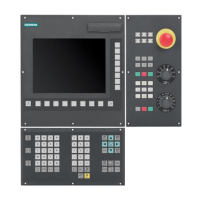Programming
8.12 Language commands for nibbling and punching
8-196
SINUMERIK 802D sl Operation and Programming Nibbling (BP-N), 06/2006 Edition
6FC5 398-3CP10-0BA0
In contrast to SON, however, a stroke is only executed at the end of the block or, in the case
of automatic path segmentation, at the end of a path segment. PON has an identical action
to SON in the case of blocks which contain no traversing information.
Programming example for PON
;
N100 Y30 SPOF ; Positioning without stroke initiation
N110 X100 PON ; Activate punching, stroke initiation at the end of the
positioning process (X=100)
PONS Punching ON (in the position controller cycle)
PONS behaves in the same way as PON. For explanation, please refer to SONS.
PDELAYON Punching with delay
PDELAYON is a preparatory function. This means that PDELAYON is programmed prior to
PON. The punching stroke is output with a delay when the programmed end position is
reached.
The delay time can be defined in seconds using the following setting data:
SD42400 PUNCH_DWELLTIME.
If the defined value cannot be divided as an integer into the interpolation clock cycle, then it
is rounded to the next divisible integer value.
The function has a modal action.
PDELAYOF Punching OFF with delay
PDELAYOF deactivates punching with delay, i. e. the punching process is continued nor-
mally. PDELAYON and PDELAYOF form a G code group.
Programming example for PDELAYOF
;
N170 PDELAYON X100 SPOF ; Positioning without punch initiation; activation of
; punch initiation with delay
;
N180 X800 PON ; Activate punching. When the end position is reached,
; a punching stroke is output with delay
;
N190 PDELAYOF X700 ; Activate punching with delay; standard
; punch initiation ON. End of programmed motion
SPIF1 Activation of the first punching interface
SPIF1 activates the first punching interface. The stroke is controlled through the first pair of
fast I/Os (see machine data:
MD26004[0] NIBBLE_PUNCH_OUTMASK,
MD26006[0] NIBBLE_PUNCH_INMASK).
The first punching interface is always active after a reset or control system power up. If only
one interface is used, then it need not be programmed.

